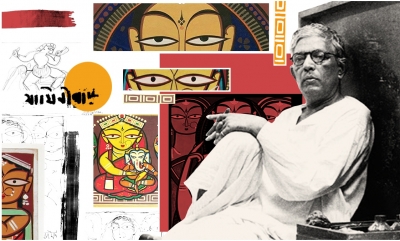
Jamini Roy was an Indian painter. He was honoured with the State award of Padma Bhushan in 1955. He was one of the most famous pupils of Abanindranath Tagore, whose artistic originality and contribution to the emergence of art in India remains questionable.
Jamini Roy was born in the year 1887 at Beliatore village in the Bankura district of West Bengal. Roy was born into an affluent family of land-owners. His father, Ramataran Roy, resigned from his government services to pursue his interest in art. In the year 1903, when he was only 16 years old, Jamini Roy left his village and made it all the way to Calcutta (now Kolkata) to enroll himself at the Government College of Art. There, he received education under Abanindranath Tagore, famous for his valuable contribution in the field of modern art. Tagore was the vice principal of the college and trained Roy as per the prevailing academic tradition. Roy finished his education in 1908 and was given a Diploma in Fine Arts. Roy was true to the art that he learned and started painting in accordance with the Western classical style. But he straightaway realized that his heart belonged to some other form of art.
Jamini Roy’s paintings that belong to the early 1920’s reflect the influences of the Bengal School of art. Initially, he came up with some excellent paintings that marked his entry into the Post-Impressionist genre of landscapes and portraits. Later in his career, several of his many paintings were based on the everyday life of rural Bengal. Then, there were numerous ones revolving around religious themes like Ramayana, Radha-Krishna, Jesus Christ, etc. Jamini Roy also painted scenes from the lives of the aboriginals called Santhals. Throughout his works, his brush strokes were largely bold and sweeping. Around mid-1930s, Jamini Roy moved away from the conventional practice of painting on canvases and started painting on materials like cloth, mats and even wood coated with lime. He also started experimenting with natural colors and pigments derived from mud, chalk powder and flowers instead of European paints.
Picture Credit : Google

